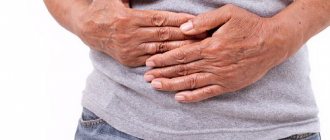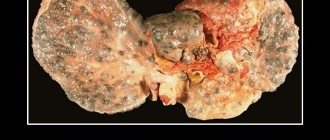The drug Baktisubtil was created specifically within the framework of the microbiological safety program by the French pharmaceutical company Patheon France. The probiotic is effective both in the treatment of gastrointestinal diseases and for preventive purposes. Promotes the rapid restoration of disturbed intestinal microflora, normalizes metabolic processes in the body, and improves immunity.
The effectiveness of Baktisubtil has been proven by clinical studies. The drug has a powerful effect, completely restoring the structure of the disturbed microflora of the gastrointestinal tract, and has a wide spectrum of action.
Description and composition
Bactisubtil is a eubiotic. Such drugs are also called probiotics. They contain microorganisms that are not pathogenic for humans and at the same time have an antagonistic effect on the pathogenic flora in the intestines. The mechanism of action is based on:
- Blocking the action of harmful bacteria.
- Increasing the barrier function of the intestinal wall and mucin production.
- Reducing the amount of inflammatory mediators.
- Increased immune function.
Thanks to this, Baktisubtil exhibits the following effects:
- Antimicrobial.
- Antidiarrheal.
The dried spores contained in Baktisubtil are resistant to the action of gastric juice, therefore they are successfully converted into vegetative forms in the intestines.
Customer Reviews
Margarita Petrovna When my daughter was very tiny, for a long time I could not cure her of staphylococcus, which she caught in the maternity hospital. I was lucky that I ended up with a competent pediatrician, who prescribed us to take Baktisubtil. After reading the instructions, I realized that I could trust the drug - it has no contraindications. But most importantly, it contains special bacteria that have an antimicrobial effect against pathogens. I can confidently say that this is the best drug that restores natural microflora. Suitable for everyone - babies, pregnant women, adults. Now we can’t go anywhere without it. We always take Baktisubtil on trips, especially to the sea. You never know what can happen in a different climate, and the food there is unusual. Another thing I do when someone has diarrhea is to first give them activated charcoal to cleanse the intestines. And a few hours later, a Baktisubtil capsule. Usually one or two days are enough for the stool to completely normalize. I recommend to all!
Alexandra The advantages of Baktisubtil are that it helps to quickly restore the intestinal microflora after antibiotics and instantly treats diarrhea. We “met” the drug when my son became very ill. The respiratory disease was accompanied by high fever, severe cough, and runny nose. The complication was bronchitis. As a result, a course of antibiotics was prescribed. His condition improved, and his son quickly recovered. But a new problem arose - the microflora was disrupted. The doctor prescribed Baktistatin, but we could not find it at the pharmacy. Then the pharmacist recommended buying Baktisubtil, saying that the microorganisms included in its composition would quickly restore the flora. The drug helped literally on the second day! So take it with confidence, don’t hesitate. It heals quickly, accurately hitting the target, and at the same time absolutely harmless!
Indications for use
for adults
Baktisubtil is used for:
- Treatment and prevention of dysbacteriosis.
- Elimination of acute and chronic diarrhea.
- Reducing the inflammatory process in enterocolitis and colitis.
for children
Approved for use from 7 years of age, in accordance with indications for adult patients.
for pregnant women and during lactation
There is insufficient data on the use of Bactisubtil in pregnant and lactating women, so it is not recommended to prescribe it to this category of patients.
Action of Baktisubtil
- The normal microflora of the gastrointestinal tract is effectively and quickly restored. The probiotic has a bacterial antidiarrheal and antimicrobial effect.
- The body's defenses increase. Diseases of the intestines, respiratory organs, pancreas, and stomach are prevented.
- Disturbed food processes are normalized.
- Toxins and breakdown products are removed.
- The manifestations of peptic ulcers, pancreatitis, gastritis, intestinal and vaginal dysbiosis are reduced.
- Prevents disruption of synthesis.
- Has a detoxifying effect.
- Promotes the formation of B vitamins
- The incidence of infectious and respiratory diseases is decreasing.
- The drug is indicated for the treatment and prevention of diseases in children from the first days of life.
Read: Dufamishki - a useful prebiotic for children.
Applications and dosages
for adults
Bactisubtil is taken before meals. The capsule should be taken with water. The liquid should not be hot.
A single dose for adults is 2 capsules. The frequency of administration is determined by the doctor and can be from 2 to 4 times a day. The course of treatment usually lasts 7-10 days.
for children
For children from 7 to 14 years old, Bactisubtil is prescribed 2-3 times a day. A single dose can be 1 or 2 capsules. The course of treatment is 7-10 days. For children over 14 years of age, the drug can be prescribed in adult dosages.
Some pediatricians prescribe Baktisubtil for children from 3 to 7 years old. In this case, the capsule of the medicine must be opened, and the powder inside it must be added to food or a small amount of liquid and drunk.
special instructions
If the condition does not improve within 3 days of using Baktisubtil, you should consult a doctor to clarify the diagnosis and possibly adjust the treatment regimen.
Baktisubtil should not be taken with hot drinks, since at high temperatures the “good” bacteria die. During treatment with this drug, you should refrain from drinking alcoholic beverages.
The manufacturer has not provided data on the safety of using Bactisubtil during pregnancy, so the decision on the advisability of taking the drug during this period of a woman’s life should be made only by the attending physician.
The bacterial spores contained in the drug are resistant to the action of various medications, in particular antibiotics and sulfonamide drugs, and therefore can be used simultaneously. However, the patient should inform the doctor about medications taken concurrently.
Analogs
There is no exact preparation of a similar composition for Bactisubtil capsules. However, other drugs from the group of probiotics have similar properties. You can replace Baktisubtil with the following drugs:
- Linux. A popular drug, opinions about which are divided. Some patients claim that it helps very well, others do not notice any results. Linex contains several types of bacteria (lactobacteria, bifidobacteria and enterococcus), thanks to which the therapeutic effect is achieved faster. It increases the body's resistance to adverse factors and suppresses the active growth of pathogenic flora.
- Bifiform. Contains bifidobacteria and enterococci. The therapeutic effect is the same as that of Baktisubtil. Promotes the metabolism of lactose, therefore reducing the unpleasant symptoms of patients intolerant to this substance.
- Acipol. Contains lactobacilli and kefir grain polysaccharide. Suppresses the growth of pathogenic intestinal microflora by creating unfavorable conditions for their growth. Available in capsules. Used in complex therapy of intestinal infections, dysbacteriosis, enterocolitis. It is often included in the treatment regimen for atopic dermatitis and allergic diseases, where the cleansing and immune function of the intestines is important.
- Biosporin. The bacteria in the drug exhibit high activity against pathogens of intestinal infections. Available in powder form, from which a solution for internal use is prepared. Effective for allergies of various etiologies, traveler's diarrhea, dysbacteriosis.
- Bificol. Contains bifidobacteria and E. coli. Available in powder form. Helps maintain normal intestinal microflora, suppresses the growth of pathogenic bacteria, reduces unpleasant symptoms (bloating, flatulence), stimulates the immune system and reparative processes.
- Lactiale. One of the best drugs in terms of price/quality ratio. Often prescribed by doctors and chosen by patients. Available in powder and capsule form. In pharmacies it is presented in three types for three age categories of patients. Each type differs in composition. Capsules for adult patients contain 7 beneficial strains of microorganisms.
Baktisubtil or Linex - which is better?
Linex is an analogue of Baktisubtil in terms of action in the body. It cannot be said that it performs the same functions, but the effect of taking them is almost identical. The differences between the drugs are shown in the table.
| Bactisubtil | Linex | |
| Active substance | Bacillus cereus IP 5832 | Lactobacillus acidophilu, Bifidobacterium infantis, Enterococcus faecium |
| Action in the body | Destroy pathogenic microflora and restore intestinal balance | They populate the intestines with lactic acid bacteria, promoting the predominance of beneficial bacteria over pathogenic ones, and also synthesize bacteriocins and stimulate intestinal immunity |
| Permitted age for use | From three years | Allowed from infancy (immediately after birth) |
| Price | 925-1000 rub. | 280-700 rub. |
Linex is a cheap analogue of Bactisubtil, which has a wider range of actions in the human body, and is also allowed from a very early age. But Linex cannot be used by people with lactase deficiency, and therefore Bactisubtil can be an excellent alternative in this case.
Instructions for using Linex are here.
How to replace Bactisubtil
If a patient has an allergic reaction to Bactisubtil, the eubiotic needs to be replaced. But there are no drugs yet that completely replicate Baktisubtil in composition and pharmacological action. Analogues belonging to the probiotic group of drugs can replace Baktisubtil.
These medications contain bacteria that can restore the balance of intestinal saprophytic flora. With the help of eubiotics, the growth of pathogenic microorganisms is suppressed, which eliminates the symptoms of an eating disorder in the form of flatulence, diarrhea, and heartburn.
The following medications provide normalization of intestinal microflora for diarrhea:
- Linux Forte.
- Florin Forte.
- Biosporin.
- Acipol.
- Hilak (Hilak Forte).
- Enterol.
Some drugs are cheaper than Bactisubtil (for example, Bifikol, Acipol). But they are not inferior in effectiveness to more expensive probiotics. You should purchase a new medicine to treat diarrhea only after the treatment has been prescribed by your doctor.
Side effects
According to reviews, Bactisubtil is one of the few drugs that has virtually no side effects.
However, when using it independently, it is necessary to take into account the individual needs of the body. So, if there is hypersensitivity to its active substance, then it is not recommended to use the drug. In addition, if after several days of treatment with Bactisubtil stool normalization does not occur, you should either stop taking the drug completely or consult a doctor.
Price
To begin with, it is worth noting that this medicine is of imported “origin” and its pricing policy is appropriate.
However, despite the high cost of the medicine, its effectiveness is unconditional. So, let's actually get acquainted with the price of the drug, both in Ukraine and Russia.
- Russia – 927.00 rubles;
- Ukraine – 530 UAH.
Contraindications and side effects
The drug has few contraindications for use, as it is generally well tolerated. Treatment of intestinal infections with Baktisubtil is not recommended for patients:
- With primary immunodeficiency.
- If you have hypersensitivity to any component of the drug.
If a patient experiences an allergic reaction after taking a eubiotic (skin rash, runny nose), preference should be given to other medications, which will be selected together with the doctor.
Usually the drug itself, like Bactisubtil analogues, does not cause side effects when dosed correctly. Only in case of hypersensitivity to the components of the drug after taking the drug may a rash or urticaria appear.
Prices for Baktisubtil and analogues in Russia
You can buy Baktisubtil in online pharmacies with delivery to all regions of Russia or in stationary pharmacies in your city. Due to the fact that the drug is produced in France, its cost is slightly higher than the cost of analogues in terms of composition or pharmacological action. Below are the prices for Bactisubtil in several Russian pharmacies:
| Pharmacy name | Price in rub. |
| Eapteka | 1053 |
| Аptekainet | 840 |
| Med-otzyv | 985 |
| MEDSIDE | 997 |
The price range for this probiotic is quite large, and on average its cost in pharmacies will be about 1000 rubles. Below is the cost of analogues:
| Drug name | Average price in Russia (in rubles) |
| Acylact | 123 |
| Acipol | 300 |
| Biolact | 450 |
| Bifidumbacterin | 247 |
| Bificol | 520 |
| Bifiliz | 550 |
| Bifiform | 580 |
| Latium | 500 |
| Linex | 544 |
| Enterogermina | 1600 |
Next, we will consider in detail the principle of choosing alternative medications and their pharmacological action.
Terms and conditions of storage
Baktisubtil capsules have a shelf life of 3 years if the integrity of the packaging is not compromised. In order for the drug to retain its beneficial properties for as long as possible, it is necessary to follow the storage conditions recommended by your doctor:
- Temperature regime – no more than 25 degrees.
- Low humidity.
- No direct sunlight.
Places where the drug is stored should not be accessible to children. Although cases of drug overdose are not described in the official instructions, safety measures should not be neglected.
( 1 ratings, average: 5.00 out of 5)
Evaluation of the clinical effectiveness of the drug Bactisubtil
Diarrhea is one of the most common intestinal disorders in the clinic of internal medicine [1–3]. Diarrhea refers to frequent bowel movements with the release of liquid or pasty stool. Diarrhea is characterized by the following signs: frequent (more than 2-3 times per day) bowel movements, an increase in the total mass of feces (more than 200 g per day), an increase in the water content in feces from 60-75% to 85-90%. Taking into account the mechanisms of development, the following types of diarrhea are distinguished: Secretory - caused by hypersecretion of water due to activation of adenylate cyclase. Its causes are enterotoxigenic infections; hormone-producing tumors; taking laxatives from the group of anthraquinones (senna, buckthorn), prostaglandins, cytostatics; idiopathic malabsorption of bile or long-chain fatty acids (eg, due to ileal resection); graft versus host disease. Osmotic (hyperosmolar) - associated with the presence of unabsorbed osmotically active substances in the intestinal lumen. The causes of osmotic diarrhea include enzymopathies (lactase, disaccharidase deficiency), pancreatic insufficiency, celiac disease, dumping syndrome, and some medications (osmotic laxatives - magnesium sulfate, mannitol, sorbitol). Exudative - caused by damage to the integrity of the epithelium due to inflammatory bowel diseases (ulcerative colitis, Crohn's disease), radiation injuries, ischemic colitis, intestinal tuberculosis, diverticulosis, malignant neoplasms, intestinal infections (dysentery, salmonellosis). Motor (hyperkinetic) – associated with disturbances of intestinal motility that develop with irritable bowel syndrome (IBS), diabetic enteropathy, thyrotoxicosis, scleroderma, after vagotomy. Diarrhea caused by taking antibacterial agents (antibiotic-associated diarrhea - AAD) deserves special attention. It is one of the most common complications of antibiotic therapy (frequency 5–30% depending on the group of drugs used). Many factors may be involved in the development of AAD. Antibiotics can directly increase intestinal peristaltic activity (clavulanic acid); disrupt the integrity of the intestinal mucosa, creating conditions for superinfections and activation of facultative and opportunistic microorganisms; weaken the enzymatic functions of normal microflora and disrupt colonization resistance. Diarrhea may be the result of incomplete absorption of antibacterial agents (cefoperazone, cefixime). There are a number of symptomatic medications used to treat diarrhea. These, in particular, include probiotics - cultures of bacteria with antagonistic properties (Enterol, Baktisubtil, etc.) [4–7], used to correct dysbiotic changes in the intestine. Baktisubtil contains dried powder of bacteria strain Bacillus cereus IP 5832 (1 billion spores) 35 mg, calcium carbonate - 25 mg, kaolin - 100 mg. Germination of bacterial spores occurs in the intestines. Vegetative forms of bacteria prevent the growth of putrefactive opportunistic microflora, activate macrophages, synthesize amino acids, and release enzymes that break down proteins, fats and carbohydrates. Thanks to the production of antibiotic substances, enteropathogenic bacteria strains E. coli, Staphylococcus aureus, bacteria of the genus Proteus, etc. are eliminated. Baktisubtil has found wide use in infectious diseases practice as a means of empirical therapy in the complex treatment of acute intestinal infections (salmonellosis, dysentery, escherichiosis, foodborne toxic infections). The drug is actively used in therapeutic, gastroenterological, pediatric practice in the complex treatment of enteritis of various etiologies, functional intestinal diseases (FBD), during and after antibacterial therapy, etc. Baktisubtil can be used as a first-line drug for the treatment of the following types of diarrhea: – infectious (caused by bacteria and viruses); – antibiotic-associated (including its prevention during antibacterial therapy); – medicinal; – caused by FZK and organic intestinal diseases. In addition, Baktisubtil (due to its ability to normalize the intestinal environment, which promotes the activation of obligate, indigenous microflora) is a means of correcting microbiocenosis disorders. The purpose of this study was to evaluate the clinical effectiveness of the drug Bactisubtil in the treatment of FCD with diarrhea syndrome and in the prevention of dysbiosis in patients with lung diseases during antibacterial therapy. Material and methods Three groups of patients were examined: • The first group – 20 patients with FCD (average age of the examined – 41.5±7 years, men – 5, women – 15). IBS with diarrhea predominance (IBS-D) was observed in 11 people, functional diarrhea (FD) was observed in 9 people. • The second group - 10 patients (men - 3, women - 7) with chronic and acute lung diseases (APD) who received antibacterial therapy. The average age of the patients was 41.7±7.5 years. 5 people were diagnosed with chronic bronchitis in the acute stage, 5 with acute pneumonia. • The third group (control) – 10 patients (men – 4, women – 6) with chronic and acute LD who received antibacterial therapy. The average age of the patients was 44.3±8.6 years. 6 people had chronic bronchitis in the acute stage, 4 had acute pneumonia. Patients of the first and second groups were prescribed Bactisubtil 2 capsules 3 times a day for 10 days. The criteria for assessing the effectiveness and tolerability of Baktisubtil were: – dynamics of changes in clinical symptoms; – bacteriological examination of stool; – transit time of activated carbon through the intestines (carbolene test); – determination of short-chain fatty acids (SCFA) in feces as an integral indicator of the state of the intestinal microflora [5,8–10]. These parameters were assessed before the start of treatment with Baktisubtil and after its completion. Results and discussion Efficacy of Baktisubtil in the treatment of FCD All patients with IBS-D and FD complained of abdominal pain of varying intensity and localization. They also noted a change in the nature of the stool and its consistency, bloating, rumbling and flatulence (Table 1). From the data presented in 1 it follows that, against the background of a 10-day course of treatment with Baktisubtil, all patients with FCD showed pronounced positive changes in clinical symptoms. In particular, in 75% of patients, stool frequency completely returned to normal, and in 25%, stool frequency decreased, in 95% it became formed or semi-formed, etc. The time it takes for coal to pass through the digestive tract as a result of treatment with Baktisubtil increased by more than 2 times. When examining stool before starting treatment with Bactisubtil, patients with FCD were found to have a deficiency of obligate flora and the presence of opportunistic microflora. A decrease in the number of bifidobacteria was detected in 20 people, lactobacilli - in 17. Opportunistic flora was detected: fungi of the genus Candida - in 5 people, Staphylococcus aureus - in 6, opportunistic enterobacteria - in 9 people. Most often, dysbacteriosis of grade 2–3 was observed in patients with FCD (Table 2). As a result of treatment with Bactisubtil, positive changes were noted in the composition of the colon microflora. The number of patients with dysbiosis of 2-3 severity decreased from 80 to 45%. On the contrary, the number of patients with dysbiosis of 0–1 severity increased from 10 to 55%. After treatment, the number of patients with normalization of obligate microflora increased. The number of patients in whom opportunistic flora was isolated, on the contrary, decreased. Before treatment, in patients with IBS-D and FD, an increase in both individual SCFAs and their total amount was noted in the feces. This indicates increased activity of microflora producing SCFA (Table 3). After a course of treatment with Baktisubtil, a decrease in the absolute content of individual acids was observed: propionic, isobutyric, butyric, isovaleric, valeric, as well as a decrease in their total amount. This may indicate a decrease in the functional activity of the colon microflora due to the normalization of the motor-evacuation function of the intestine [11–12]. The profiles of C2–C4, which make the main contribution to the total pool of SCFA, were studied in patients. Initially, in patients with FCD, a significant increase in the relative content of propionic and butyric acids was noted in the feces with an increase in the level of acetic acid in the general C2-C4 pool compared to the group of healthy individuals. The presence of these changes in patients with diarrhea syndrome indicates an increase in the number and activity of the anaerobic microflora, represented mainly by populations of microorganisms of the genera Bacteroides, Clostridium, etc. [11]. After a course of treatment with Baktisubtil, there is a tendency towards normalization of the C2–C4 profile, which provides conditions for the activation of obligate microflora. In the overall assessment of the effectiveness of treatment with Baktisubtil, the absence of clinical manifestations of the disease and normalization of laboratory parameters were taken as clinical remission. Significant improvement was noted with a decrease in clinical symptoms and changes in laboratory parameters by more than 50%. An improvement was defined as a decrease in clinical symptoms and a change in laboratory parameters of less than 50%. After treatment with Baktisubtil, clinical remission was noted in 9 patients, significant improvement in 3, improvement in 5. Thus, the effectiveness of treatment for FZK with Bactisubtil was 85%. Efficacy of Baktisubtil against the background of antibacterial therapy All patients with LM included in the study received antibacterial therapy using broad-spectrum (90%) and selective (10%)-spectrum antibiotics. All patients initially showed symptoms of intestinal dyspepsia, which were probably associated with the antibiotic therapy (Table 4). After 10 days of taking Baktisubtil against the background of antibacterial therapy, positive changes were noted in the clinical symptoms of intestinal dyspepsia: the pain symptom was relieved in all patients who noted it, rumbling in 5 people, flatulence in 2. After treatment with Baktisubtil, stool consistency and frequency of bowel movements normalized: periodic relaxation after treatment was detected in only 1 patient. However, 3 patients developed constipation by the end of treatment, which resolved spontaneously after discontinuation of Baktisubtil. The frequency of detection of pathological impurities in feces decreased from 40 to 10%. At the same time, in the control group that received only antibacterial therapy, there was an increase in the symptoms of intestinal dyspepsia. During bacteriological examination of stool, intestinal dysbiosis of varying severity was determined in all patients against the background of antibacterial therapy (Table 5). Treatment with Bactisubtil reduced the severity of dysbiosis; in the control group, on the contrary, it increased slightly. During antibacterial therapy, changes were noted in the composition of the main, facultative and residual microflora of the colon. After treatment with Baktisubtil, patients in the main group observed an increase in the number of obligate flora (bifidobacteria), a decrease in cases of detection of defective and hemolyzing Escherichia coli, clostridia, and the number of opportunistic enterobacteria. At the same time, fungi of the genus Candida continued to be detected in them. In the control group (without Baktisubtil administration), there was a decrease in the amount of obligate flora; the initial frequency of detection of defective and hemolyzing Escherichia coli, clostridia, opportunistic enterobacteria, and fungi of the genus Candida was maintained. The data obtained allow us to recommend the use of the drug Baktisubtil in the restoration of microbiocenosis disorders associated with antibacterial therapy. SCFA content was assessed in the stool of patients in both groups. Initially, there was a sharp (3–3.5 times) decrease in the absolute concentration of SCFA compared to the norm. As a result of therapy with Bactisubtil, there was a tendency to increase the concentrations of individual SCFAs and their total content. In the control group, the opposite trend was noted. During treatment with Bactisubtil, the C2–C4 profile also shifted towards normal values: the relative content of acetic acid increased, and the proportion of butyric acid decreased. Conclusions 1. The drug Bactisubtil is an effective treatment for patients with FCD (IBS-D and functional diarrhea). The clinical effectiveness of Baktisubtil was 85%. 2. Bactisubtil is a drug that changes the intracavitary environment of the colon, which is expressed by changes in the composition and spectrum of SCFA. 3. Treatment with Baktisubtil promotes positive changes in colonic microbiocenosis, which is confirmed by microbiological research data. 4. Baktisubtil is an effective drug for the prevention of dysbiotic disorders during antibacterial therapy.
Literature 1. Ivashkin V.T., Sheptulin A.A. Diarrhea syndrome. Geotar Medicine, Moscow, 2000. p. 135. 2. Zlatkina A.R. Pathophysiological mechanisms of diarrhea // Mucocytoprotection, pathophysiological and clinical aspects. M., 1998. pp. 15–20. 3. Parfenov A.I. Diarrhea //Russian Medical Journal, 1998. No. 7. With. 440–448 4. Elizavetina G.A., Ardatskaya M.D., Minushkin O.N. Chronic bowel diseases. Modern view on etiology, pathogenesis, diagnosis and treatment (review) // Kremlin Medicine 1998. No. 2. pp. 22–25. 5. Ardatskaya M.D. Clinical significance of short-chain fatty acids in gastrointestinal pathology. Author's abstract. Doctoral dissertation, M.: 2003, p. 48. 6. Minushkin O.N., Ardatskaya M.D., Dubinin A.V. Intestinal dysbiosis: modern aspects of studying the problem, principles of diagnosis and treatment (review). // Therapeutic archive. 2001. No. 2. p. 67–72. 7. Minushkin O.N., Minaev V.I. (ed), Mitrokhin S.D., Ardatskaya M.D. and others (compilers), Complex diagnosis, treatment and prevention of intestinal dysbiosis (dysbiosis) in the clinic of internal diseases of the MC UD PRF (methodological recommendations), M.: 1997. 8. Babin V.N., Minushkin O.N., Dubinin A. .V et al., Molecular aspects of symbiosis in the host-microflora system; Russian Journal of Gastroenterology, Hepatology, Coloproctology, 1998. No. 6. pp. 76–82. 9. Short Chain Fatty Acids./ Congress Short Report Falk Symposium, comp. by Scheppach W. – Strasbourg, 1993. – p. 50. 10. Ardatskaya M.D., Ikonnikov N.S., Minushkin O.N.. RF Patent “Method for separating a mixture of fatty acids of the C2–C6 fraction by gas-liquid chromatography” No. 2220755, priority dated July 23, 2002. 11. Gottschalk G. Metabolism of bacteria. Per. from English M.: MIR, 1982. p. 445. 12. Ardatskaya M.D., Minushkin O.N., Nonikov V.E. and others. The content and profile of volatile fatty acids in the feces of pulmonary patients before and after antibacterial therapy (facts and reflections). // Clinical Bulletin, 1995. No. 3. pp. 13–15.











